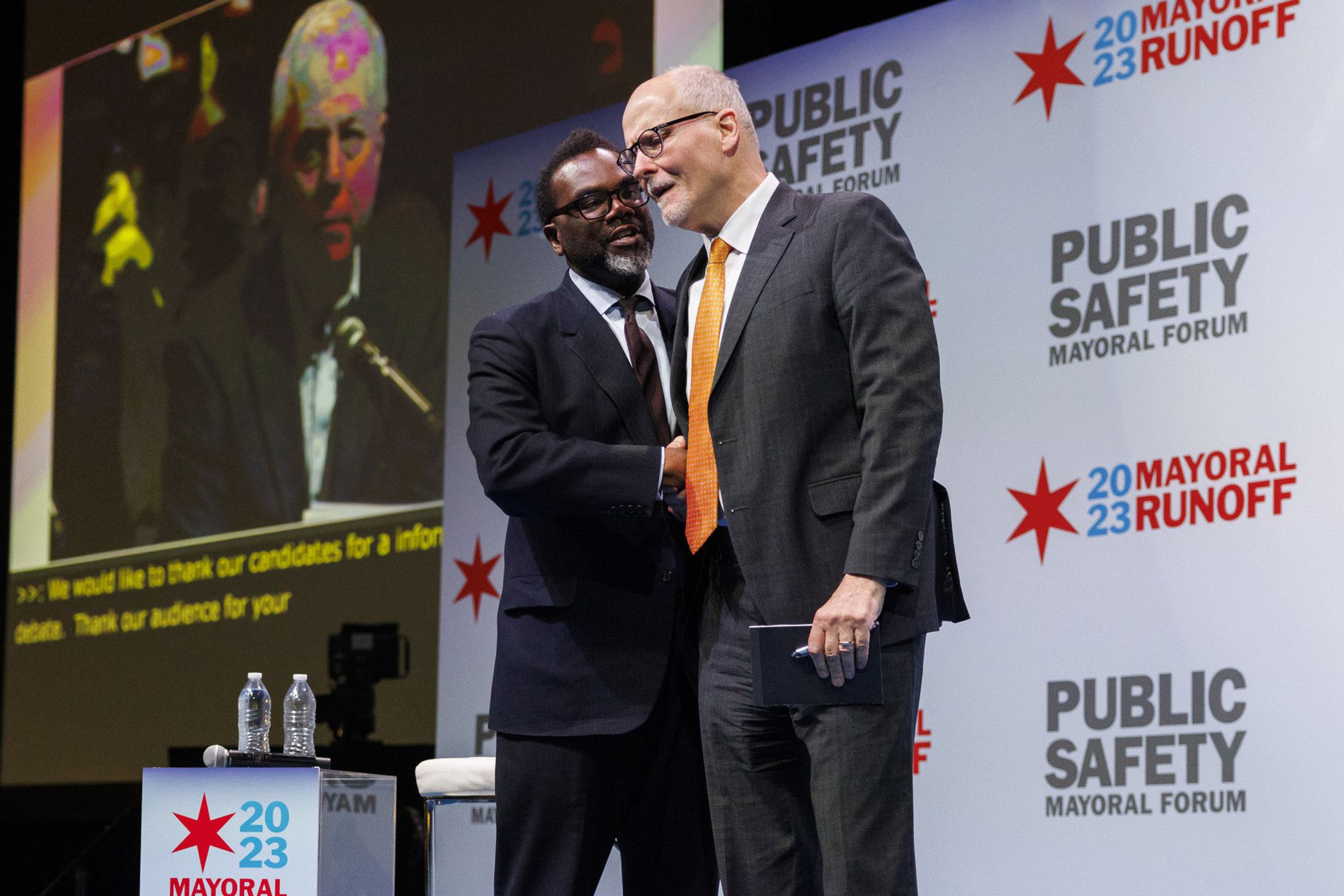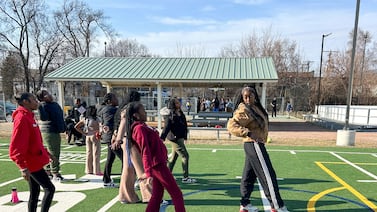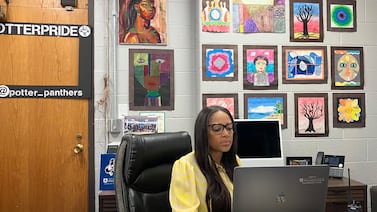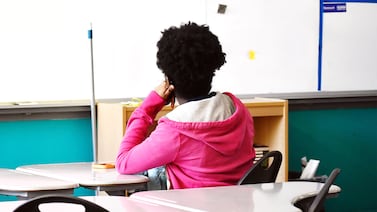Chicago’s two mayoral candidates have starkly different visions for reckoning with the city’s steep enrollment losses and under-enrolled schools.
Paul Vallas has said these shrinking campuses could become or share space with specialized magnets, charter schools, or alternative high schools — the kinds of overhauls he oversaw during his tenure as Chicago Public Schools CEO from 1995 to 2001. The city should continue to give families more quality choices, he argues.
Brandon Johnson, on the other hand, says Chicago’s system of choice — in which families can pick from a myriad of district-run, charter, and private programs anywhere in the city — has created a “Hunger Games scenario” in which neighborhood schools lose out to better-funded competitors. The solution, the Chicago Teachers Union organizer says, is a major influx of resources for schools that already exist.
The divide between Vallas and Johnson — both Democrats facing off in an April 4 runoff — embodies the party’s swings and tensions on school choice and other education policies. And it comes at a pivotal time for Chicago, which will transition away from mayoral control to an elected school board in 2025 as a moratorium on school closures ends.
Both candidates’ plans raise questions. The approach of fully rebranding struggling schools Vallas champions has a checkered record, and it would come after three years of COVID-era disruption for students. He has called for expanding the city’s alternative high schools to reengage students who disconnected from school during the pandemic, but these campuses have no shortage of seats after massive enrollment losses recently.
Yet with leaner times looming after federal COVID relief money runs out, it’s tough to say whether the city can pull off the significant influx of resources Johnson wants to revitalize all of its shrinking schools. It would be up against demographic headwinds reducing the number of school-age children — and costs that have swelled to as much as $40,000 per student a year at some under-enrolled high schools, compared with $13,000 on average.
Kate Phillippo, a professor in Loyola University’s Schools of Social Work and Education, notes the city’s system of choice, where most students travel to magnet, charter, or private schools rather than attend their assigned neighborhood campus, is likely here to stay. But it’s also under pressure as the number of small schools grows.
“What we don’t need in Chicago is more schools, unless we are doing it with the goal of other schools going away,” said Phillippo. “I don’t know how much more choice we can introduce.”
More recently, the two mayoral candidates have walked a careful line on charter schools and school choice, with Vallas suggesting that the city actually doesn’t need more charters, and Johnson stressing that he doesn’t oppose them. But their platforms and records are illuminating.
Vallas, a well-known education reformer who helped to remake New Orleans as a charter-centric district after Hurricane Katrina, is a pro-school choice Democrat in the mold of former U.S. Secretary of Education Arne Duncan, but he has also broken with the Democratic canon in backing an expansion of an Illinois program that pays for some students to attend private schools. Johnson, a Cook County commissioner and former teacher, is staking out a more traditional Democratic position, based on steering more money to traditional public schools.
Vallas argues expanding school choices remains important
If elected mayor, Vallas has made it clear that he would work to support the system of school choice that he promoted as the district’s CEO, when he touts presiding over the creation of 78 magnet, charter, and other schools.
His approach was a precursor to what became known as the “portfolio model” of managing districts — a decentralized, open-enrollment system where cities incentivize high-performing schools and close or restructure struggling campuses. The model was popular in the 2010s, but it has lost much of its luster in more recent years. Research has shown mixed results for students, and advocates have come to champion a less top-down approach based on trust and buy-in from local communities.
On the campaign trail today, Vallas has tried to reflect that shift. He said he wants to empower local communities to invite charter schools into under-enrolled or vacant buildings to take over or share space with traditional schools. Struggling schools could also be converted into magnets or other models, making them more attractive to students and families. He has singled out for expansion the Youth Connection Charter School, or YCCS, network of alternative charters that serve former dropouts and students at risk for dropping out.
At a Saturday mayoral debate hosted by the Chicago Women Take Action Alliance, Vallas — who helped engineer major, polarizing expansions of charters and school choice in New Orleans and Philadelphia — distanced himself from the unchecked growth of charters in Chicago under his successors. He said his administration only green-lit 15 such schools. His focus instead, he said, was on launching specialized magnet programs, such as International Baccalaureate and STEM, housed within traditional neighborhood schools. With enough charters in the city already, he will again focus on pushing for such programs.
“We were very cautious about not destabilizing communities by converting schools into charter schools,” he said. But, he added, “I think it’s very important to expand quality school choice.”
In some ways, Vallas’ comments echo a broader recent conversation about saving some shrinking campuses by rethinking their offerings in a way that can draw local families. His idea of remaking struggling high schools as career and technical academies is one the district’s current CEO, Pedro Martinez, has floated as well; Johnson is also advocating for more career and technical programs.
The tempering of Vallas’ position comes at a time when the city has cooled on charters, which are public schools run by nonprofits or other private entities but in Chicago are overseen and funded by the school district.
In its 2019 contract with its teachers union, the city agreed to extend an earlier moratorium on new charter campuses and limit charter enrollment. The district has also embraced much shorter contract renewals with many more strings attached for its charter providers — more stringent oversight championed by some school board members appointed by Mayor Lori Lightfoot. Member Elizabeth Todd-Breland, for instance, has questioned recently whether charters that haven’t delivered on a promise of innovation and superior student outcomes should continue to exist.
Others see Vallas as a potential ally for charters. Andrew Broy, president of the Illinois Network of Charter Schools, said Vallas has a “long history of seeing charters as an integral part of the school system.” A Vallas proposal to do away with enrollment caps for high-performing charters resonates. But Broy said the group has not yet decided whether to endorse a mayoral candidate.
While the massive charter growth of 15 years ago is inconceivable today, Broy sees room for new innovative charters in pockets of the city with crowded schools, such as in parts of the Northwest Side. Broy, who has decried what he sees as cumbersome charter contract renewals, said his group hopes to work with the next mayor on creating a pathway to longer renewals.
Charters have also lost students since the pandemic began — though they have fared better than neighborhood schools. District-run schools lost roughly 10% of their enrollment since 2019, while charters lost about 6%. Alternative high schools — district-run, charter and for-profit — lost a fifth of their students, and the YCCS network that Vallas has touted was especially hard hit and forced to close two campuses.
Research by the University of Chicago’s Consortium on School Research has shown that the rapid expansion of charters in Chicago resulted in some high-performing schools. But student outcomes have varied greatly among charter campuses, said Elaine Allensworth, the consortium’s director. Ultimately, she said opening more than 100 schools as student enrollment was shrinking was bound to lead to under-enrolled campuses.
Johnson and his supporters have argued that Vallas’ approach would bring disruption to the district on the heels of COVID-era upheaval. At a recent press conference organized by the Chicago Teachers Union — a pioneer in unionizing some charter campuses in the city — charter school teachers said the city’s focus should be on steering resources toward its existing campuses. That includes charters that have lagged in beefing up their support staff and programs for students.
Ryan Lindburg, an educator at CICS Northtown Academy, said school funding in Chicago is already spread too thin, a sort of “Wild West situation.”
“What we’ve actually seen in the past is that a school opens up,” he said. “Two years later, we close it. We rebrand it. It’s a new charter. Two years later, it closes. We rebrand it. And you can’t get any stability that way.”
Johnson says neighborhood schools need major investment
Johnson believes some of the district’s enrollment challenges have stemmed from the very system of choice that Vallas champions.
He points to the closure of 50 traditional public schools a decade ago under then Mayor Rahm Emanuel, a move that was deeply controversial and, Johnson says, fed into an exodus of Black families from the city – flight that has contributed to today’s enrollment declines.
Programmatic missteps have added to the problem, he said, such as having an online preschool sign-up system that is difficult for some families to access.
But Johnson has largely refrained from bashing charters, whose parents make up a sizeable part of Chicago’s electorate. He said that families tend to love their schools regardless of the model. He has also spoken about his own family’s decision to choose public schools outside his Austin neighborhood, where he has said campuses did not offer the extracurricular and other programs his children sought.
Still, he said, “It is clear that charter school expansion forces competition for resources and ultimately harms all schools.”
He has held up the idea of making use of vacant space on under-enrolled campuses by bringing in services that their communities need — from health care clinics to child care centers.
Such steps don’t in themselves reverse flagging enrollment, and the scaling back of coursework, extracurricular options, and other resources for students it has brought. But, proponents of the idea argue, they can generate some revenue for these campuses as well as more community buy-in as they bring neighbors into the building, transforming schools into community hubs.
Johnson has also said he wants to steer resources to these small schools on par with what campuses with larger enrollments would receive: a school library with a librarian, counselors and other support staff, art programs, and sports teams. He sees these investments as part of a broader push to make South and West Side neighborhoods more attractive to families.
But that’s a heavy lift in a city where small schools are poised to play an ever more outsized role: Their number grew markedly during the pandemic, and now one in three elementary schools serves fewer than 300 children. Meanwhile, even as high school enrollment remained relatively stable, Chicago high schools that serve 250 or fewer students lost a third of their enrollments since 2019 on average. The gap between the cost of educating a student at tiny and larger campuses has grown dramatically, and Martinez has been blunt: The district is taking money from schools with healthy enrollments to subsidize its small schools.
Experts such as Phillippo are dubious that significant investments in staff and programming can counteract the effects of powerful demographic and immigration shifts that are shrinking the school-age student population across the Midwest.
Gary Miron, a professor of education leadership, research and technology at Western Michigan University who has critically examined the national growth of charters, says investing in struggling buildings can help address the central challenge of high teacher and administrator turnover they face. But the city would need a larger, coherent plan for better supporting its neighborhood schools.
“Throwing resources at these schools isn’t a good idea unless it’s part of an overall management strategy,” he said. “It’s a hard thing to do when you have a decentralized, free-market system of providing a public service.”
Sally Nuamah, a professor at Northwestern University and the author of “Closed for Democracy,” a book about the academic and other fallout from Chicago’s 2013 school closures, says it’s paramount that the next mayor seek solutions to enrollment and other challenges in tandem with local communities. When decisions take place without community input, as with the 2013 closings, they breed disillusionment and mistrust in public institutions.
Johnson recently described those closings, which disproportionately affected Black students, as “one of the most horrific acts done against a group of people in the history of the city of Chicago.”
“The next mayor needs to take seriously the potential consequences of making these decisions on the academic, emotional, and political lives of communities that have already experienced the loss of other important public institutions such as hospitals and libraries,” Nuamah said.
Lilia Guevara, a mother of three, says parents in particular are eager to be a partner in these conversations.
Guevara, who lives on the Southwest Side, has a recent graduate of a Catholic high school and twins with autism — one attending the charter Acero’s Garcia campus and another at a district-run high school. Each of those high schools has proven the right fit for the twins’ distinct needs, she said.
Guevara said she does not want to see the mayoral candidates politicize charter or other schools. Instead, she wants a commitment to appoint more parents to the school board ahead of a transition to an elected board — and to better incorporate parent voices in making decisions more generally.
“The officials are not always thinking about what we deal with as low-income parents raising human beings,” she said.
Ultimately, says Allensworth of the Consortium on School Research, schools are part of a broader, complex governance equation. Affordable housing, transportation, vibrant small businesses, and other factors influence whether families with children move to the city and stick around.
“The mayor is really the one person in a position to influence how different sectors in the city affect education,” she said.
Becky Vevea contributed to this report.
Mila Koumpilova is Chalkbeat Chicago’s senior reporter covering Chicago Public Schools. Contact Mila at mkoumpilova@chalkbeat.org.







